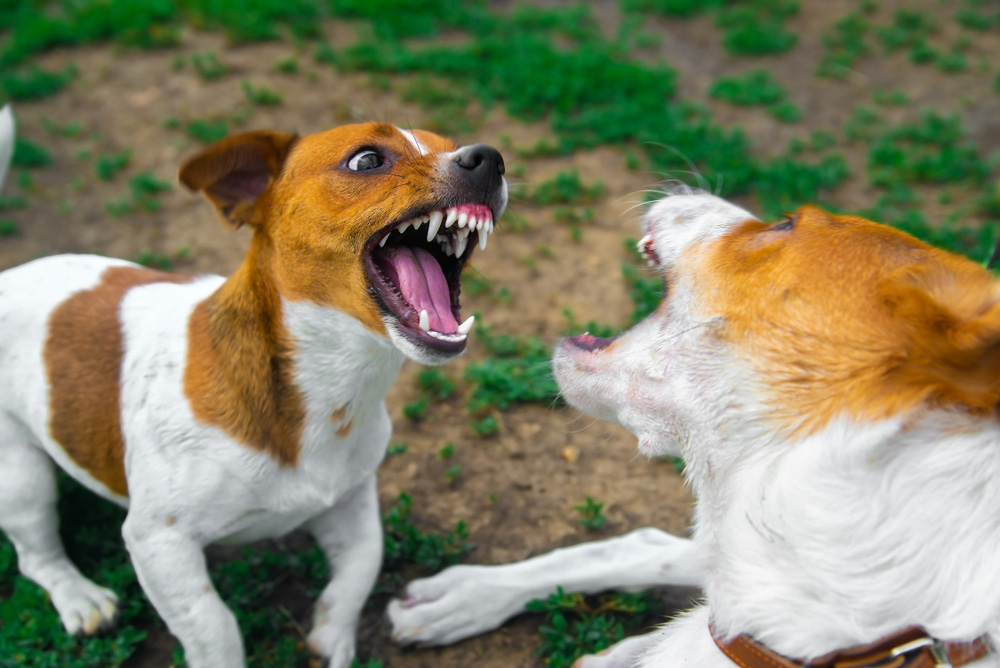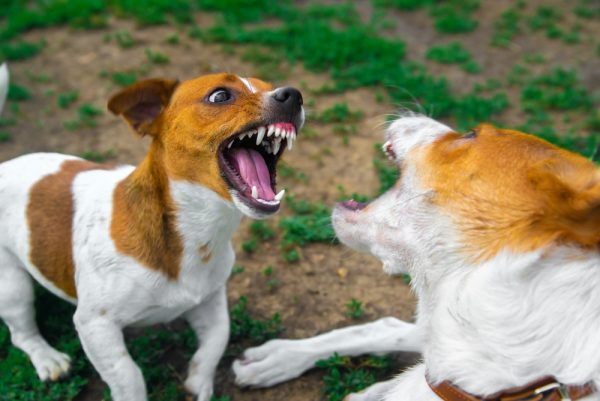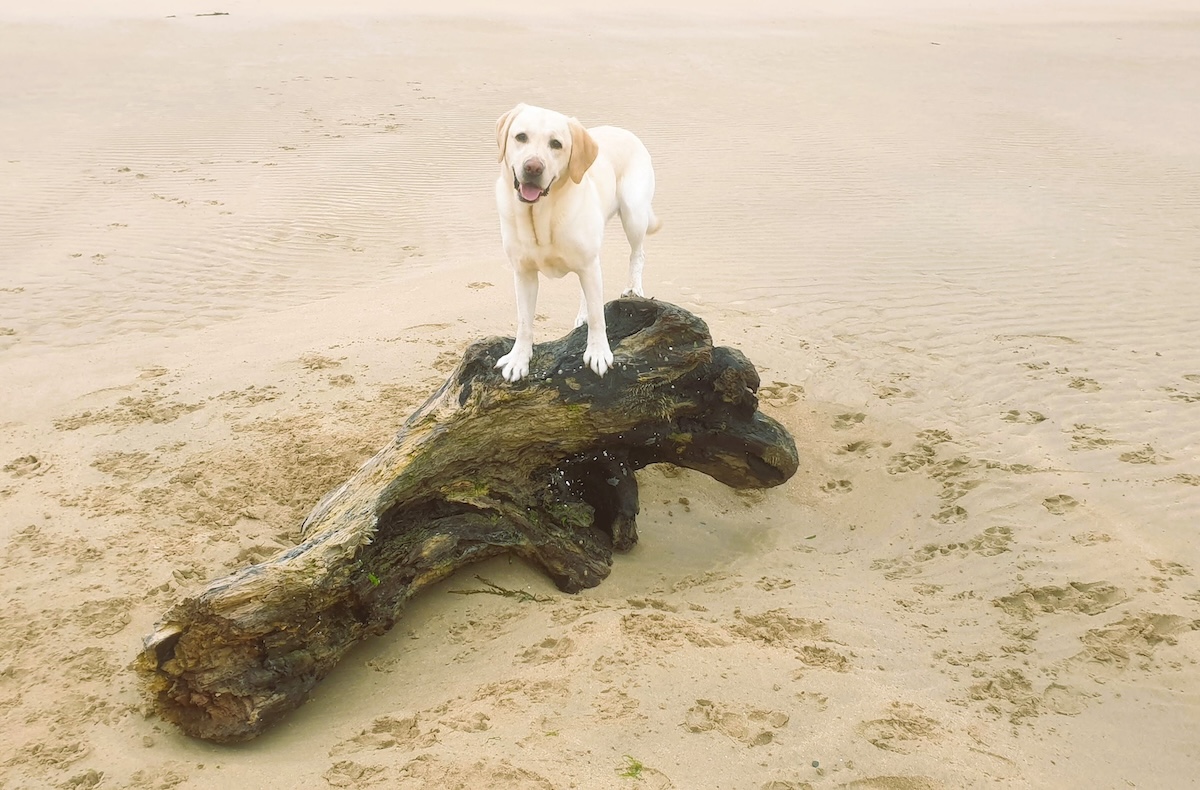Click to Skip Ahead
When you have more than one dog in the home, chaos can sometimes ensue if fights break out. It’s not unusual for a dog parent to get additional canine companions for their fur baby. However, when the new addition causes fighting and stress, it may be more than some dog owners can handle, unless they know how to prevent dogs from fighting in the first place.
In this post, we’ll list five tips for how to stop dogs from fighting so that all dogs living within the residence can live harmoniously together.

Before You Start
Fighting between dogs can obviously be dangerous for all involved or nearby. We recommend that you consult with a veterinarian or veterinary behaviorist for help with fighting or aggression problems. At all times keep yourself and family safe.
Since dogs cannot speak, they use other forms of communication, primarily body language. If one dog is agitated with the other, aggressive behavior or even a full-on attack can occur, but there will usually have been warning signs beforehand. Being tuned into these signs can help you prevent an attack.
When adopting a new dog, it’s wise to ask about any problems, such as food or toy guarding or other aggressive behaviors, so that you’re prepared to tackle the situation. Ask how they interact with other dogs and consider if their size and temperament is a fit for your household. This is especially true if you’re rescuing or adopting from a shelter.
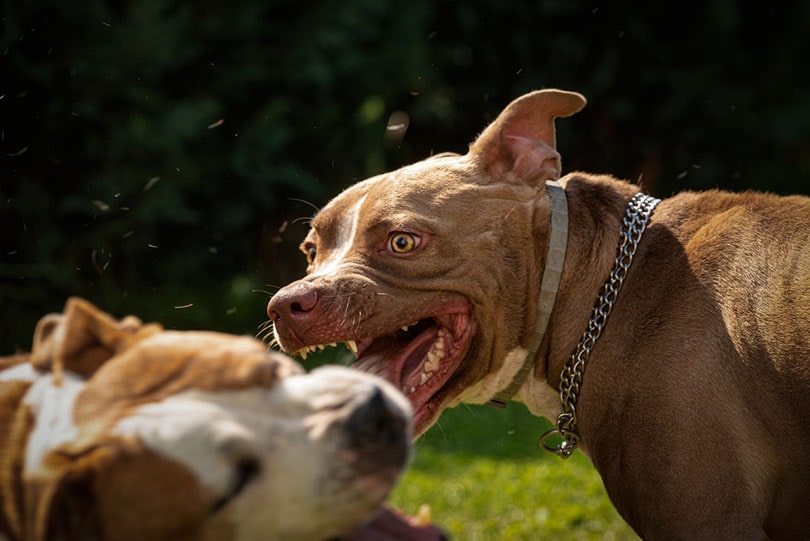
Other Considerations
If you’re planning on getting two or more dogs of the same sex, know that hormonal changes leading to aggression can occur if they are not neutered. Intact males can be aggressive to other males, females can be aggressive whilst in heat, and mother dogs can aggressively guard her puppies. However, aggression can also occur between two dogs of the opposite sex or among neutered dogs for other reasons like competition over resources or hierarchical changes.
Dog fight wounds can be extremely serious, requiring hospitalization and surgery. They can even be fatal. Both dogs and your safety should be your first priority, so separate the dogs if you believe you need to do so. Keep in mind when dogs have strong negative associations with one another, they may never get along, and your best bet is to separate them. Hopefully you’re reading this article before the aggression has escalated to that point.
Preparation
Before introducing a new dog into the home, it’s best to introduce your current dog and new dog on neutral ground and on leashes. Doing so prevents your current dog from feeling threatened, therefore reducing territorial tendencies to protect their home. The “resident dog” can become familiar with the new dog in a safer and more controlled environment, which will be beneficial when pairing them together in the same home.
Keep them at a distance at first, watching their body language. Walk them in the same direction, allowing them to scent each other’s tracks rather than greeting head on. If both appear happy and relaxed you can introduce them to each other by decreasing the distance while walking parallel to each other. Head on introductions can generate anxiety and conflict.
Before taking your new dog home, ensure you have separate crates and beds for the dogs. Some dogs do just fine sharing their bedding, but others may not fancy the idea at all. The resident dog may eventually share, but you shouldn’t expect them to do this right off the bat. Let’s now move on to suggested methods to stop household fighting among canines.
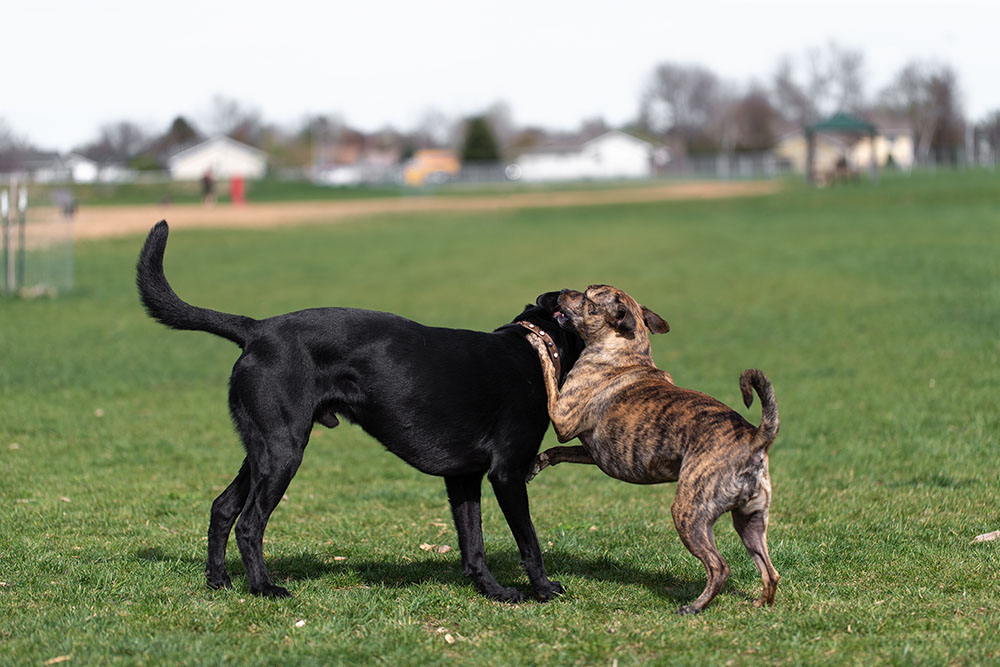
The 4 Tips to Stop Dogs From Fighting in the Same Household
1. Identify Aggressive Triggers
The first step should be to identify what causes the aggressive tendencies in the first place. The context of the aggression and your dogs’ body language will give you insight into what they are experiencing. Once you understand why the aggression occurs you can take steps to reduce the triggers. The common types of aggression are:
- Resource Guarding: When dogs act to protect a resource they see as belonging to them. Food, treats, toys, comfortable beds, and people can all be the trigger. You should separate them when resources that trigger aggression are available e.g. separate for feeding.
- Pain/Disease Related Aggression: When dogs are in pain or ill, they usually want to be left alone, and they sometimes resort to aggression to get the message across. There are also neurological diseases that increase aggression, in which case the disease is to blame not environmental triggers. You should visit the veterinarian for a treatment plan for your unwell dog.
- Redirected Aggression: When dogs see a trigger, usually a stranger or animal, that they can’t get to because of a barrier or being on a leash, they can turn their aggression onto their housemate out of frustration. You should avoid putting your dogs in situations where redirected aggression occurs.
- Fear Aggression: Fearfulness of another dog can lead to aggression. If your dog has had a bad experience or is not well socialized, they could be fearfully aggressive towards other dogs. This is also why dogs that were not the initial aggressor can become reactive towards the other dog in the house. You should apply desensitization and counterconditioning in a controlled setting. In some cases veterinarians will deem medication as an appropriate option.
- Prey Aggression: This is uncommon between dogs but can occur when a dog with a high prey drive hunts another, usually smaller, dog. You should choose dogs that are compatible with each other and continually train the dog with the high prey drive.
- Territorial Aggression: When your dog does not recognize another as a member of the group, they can become aggressive only at home. Socialize your dogs outside of the home and build trusting bonds and positive associations.
- Social Conflict Aggression: When the hierarchy in the house is in question dogs may fight for their position. This does occur but dominance is less of a problem in dogs than most people think. Implementing the “nothing in life is free” method can train dogs in the appropriate ways to get what they want.
- Sexual/Maternal Aggression: This was previously touched on with hormonal behaviors. Intact male dogs can be aggressive towards other males, female dogs can become aggressive when in heat or looking after puppies. Mothers with puppies should be left in peace. Spaying and neutering can sometimes prevent or reduce aggressive behavior. It is not appropriate in all situations though and so speak to your veterinarian or a veterinary behaviorist before going down this route.
Whatever the trigger, pinpointing the cause of the aggression is vital in resolving the issue. Does one dog like to eat alone? In that case, do not feed them in the same room. Does aggression ensue over a particular toy? If so, remove that toy unless you can supervise playtime.
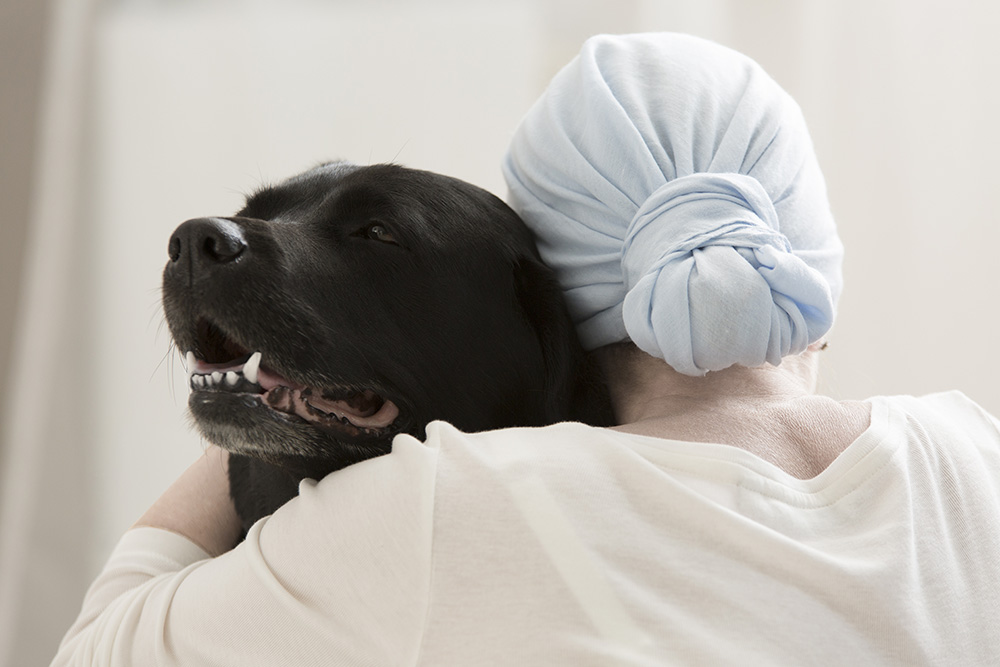
2. Get a Vet Check
Some dogs may show aggression if they are in pain. It’s recommended that both dogs be checked out to ensure there is no medical reason for the aggressive behavior. This could simply be a result of your dog not feeling well and not wanting to be bothered.
Your vet will take a history and examine both dogs. Diagnostic tests like blood tests or x-rays might be recommended to further look into any issues. Your vet will devise appropriate treatment plans and can usually give you some management strategies for your dogs. In some cases they may recommend referral to a veterinary behaviorist. This is especially true for aggression between dogs in the same household because there can be serious consequences when dogs fight.
3. Use Desensitization and Counterconditioning
Desensitization and counterconditioning can greatly benefit the situation. These behavior modification techniques change your dog’s behavior; in other words, these techniques change your current dog’s emotional response to specific triggers.
Desensitization refers to carefully and gradually exposing your dog to a trigger stimulus until the trigger no longer creates a negative response. In this case, you can gradually introduce the dogs from safe distances (on leashes) and close the gap a little more each time until you see no reaction from either dog. Ensure to give basic commands during this time and reward with treats and praise when your dog ignores the other dog and obeys the commands. If the dogs are reacting to each other, ignoring commands or food treats they are too close and you should start again further apart.
Counterconditioning works hand in hand with desensitization because it replaces the negative emotional response to a stimulus with positive emotional responses. You don’t want to reward bad behavior. Rather, start from the beginning and gradually decrease the gap, and reward when your dog shows no aggressive behaviors.
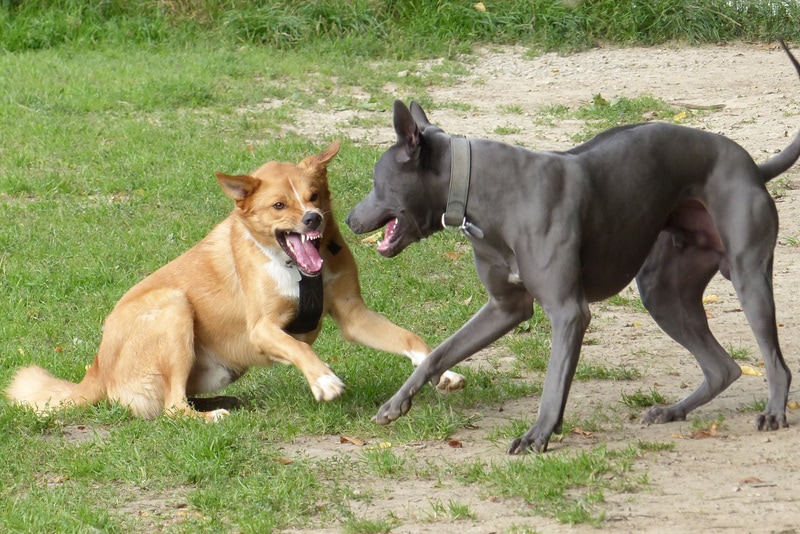
4. Implement the “Nothing in Life Is Free” Program
This approach makes all dogs in the home earn everything they get, including praise, food, treats, toys, etc., which can ease aggression because dogs learn the best way to get what they want is to calmly follow commands. For this program to be successful, all dogs living in the home must learn basic commands like “sit,” “come,” and “stay.” This program also eliminates you, the owner, from becoming something to compete over among all dogs in the household, which can prevent fighting or even eliminate it altogether.
How to Tell the Difference Between Play and Aggression
It will help you greatly to know how to differentiate between play and aggression, and it all starts with body language. Since dogs cannot speak words, they rely mainly on body language as a means of communication. For positive, non-aggressive play, look for these signs:
- Big, silly, open-mouthed grin
- Loose posture
- Play bow (front end is lowered with backside lifted)
- Play bow accompanied by slapping the front limbs on the ground repeatedly
- Dogs fall down during play to expose their bellies
- Play-growling
- Both dogs keep going back for more
- Wagging tails
Here are signs of aggression and violent play to look for:
- Raised hackles
- Stiff, rigid body
- Curled lip, closed mouth, warning growl
- Pinned ears
- High, raised tail
- Tucked tail (submissive dog)
- Submissive dog leaves the area
- Submissive dog is trying to get away
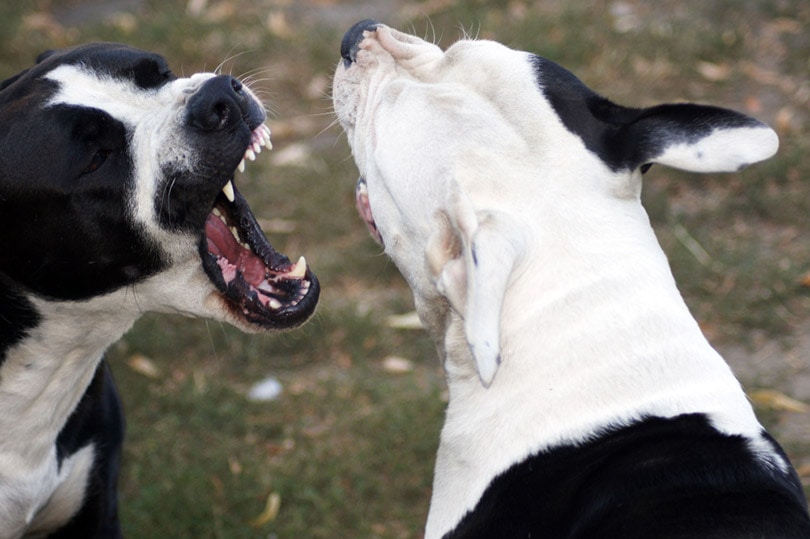
How to Safely Break Up a Dog Fight
Given that some dogs may fight in the same household, it’s vital to know how to break up a dog fight safely. You certainly do not want to injure yourself or others while trying to do so. Here are some safety measures to consider:
- Do not interject your hands or arms between the dogs’ mouths.
- Use a whistle, clank pots and pans together, or whatever means you have at the time to make a loud noise.
- Place a physical barrier (other than yourself) between the two that will not harm the dogs, such as a piece of plywood, garbage can lid, broom, or something similar.
- Use the “wheelbarrow” technique: one person grabs the back legs of one dog and you grab the other dog’s back legs, pulling the dogs apart. This should be a last resort, as the aggressive dog could turn on you, and it is only recommended for experienced dog handlers.

Conclusion
Like children, dogs may not get along within the household. However, trying these steps may help eliminate rivalries altogether. Know that it takes time and patience on your end, and don’t give up! In the worst-case scenario, you may need to rehome the newest dog to a safer environment, but the goal is to prevent this from happening.
You can also enlist the help of a veterinary behaviorist or reputable professional dog trainer to avoid rehoming the dog and prevent injuries.
Featured Image Credit: Alexandr Jitarev, Shutterstock

